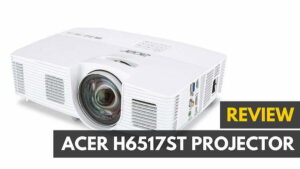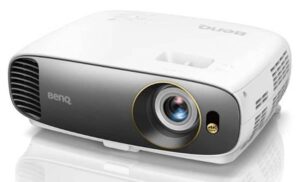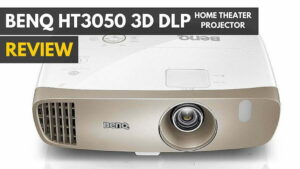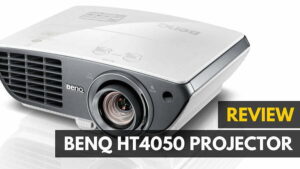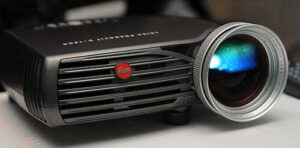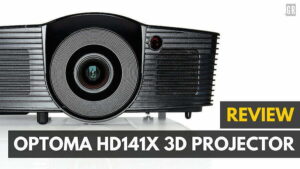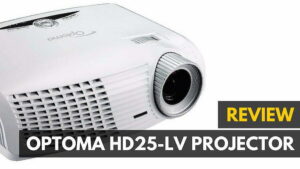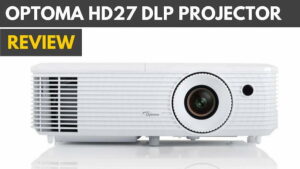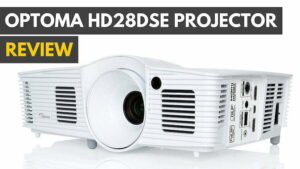The Optoma HD142X is the latest in a long line of entertainment devices made by a company that’s not here to revolutionize the way we watch media, but at the very least wants to make it more accessible for people who can’t afford the upfront cost that other home theater projectors like it might set them back. But will its budget-level price keep it from performing the way we hoped it could in our tests and be nominated to our best home theater projector list?
This best home theatre projector may just have what it takes.
Read on in our Optoma HD142X review to find out!
Overview
Price: $609.95 on Amazon
Available: Now
Model: HD142X
Summary: The Optoma HD142X is a worthy successor to the HD line of projectors from the company, and while it doesn’t do anything revolutionary, its minor improvements and longer lamp life should be enough to justify its budget-level cost of entry.
What We Liked
- 8,000-hour lamp life
- Very bright in ambient light
- Quiet and cool in high-performance scenarios
What We Didn’t
- Settings menu doesn’t have much customization
- Onboard speaker is completely lacking in bass
Optoma HD142X Specs
| Screen Size | 27.88″ – 305.5″ |
| Native Resolution | 1920 x 1080 |
| Aspect Ratio | 16:9 |
| Lumens | 3,000 |
| Contrast Ratio | 23,000:1 |
| Refresh Rates | 60Hz (144Hz in 3D) |
| 3D Capable? | |
| Display Technology | DMD DLP |
| Short Throw? | |
| HDMI Ports | 2 1.4/MHL |
| Onboard Speakers | 10W |
| Weight | 5.2 lbs |
| Device Dimensions | 9 x 11.7 x 3.7 inches |
| Price | $609.95 |
| Buy Now |
Design
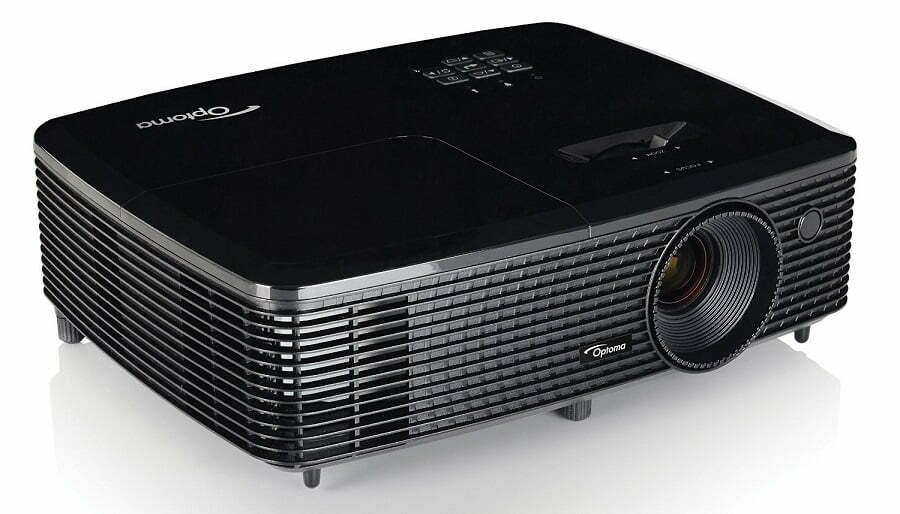
When we first reviewed the Optoma HD142X’s predecessor, the HD141X, we commented on how even through years of innovation and change, the design of projectors has stayed relatively stagnant. Sure, you might find a rounded edge or a cool bulb mount here and there, but on the whole, it’s rare to find any units – Optoma-made or otherwise – that stray very far from the tried and true designs of the past.
As much as I’d like to say that the HD142X is a projector that breaks the mold, unfortunately, it’s the same old story here as it has been with every other projector we’ve reviewed this year. Black-on-black color schemes, grated plastic on the front, and an overall boxy shape make this one of the least sexy projectors I’ve seen, saved only by its low-to-the-ground profile that might help it fit into tighter spaces where other larger projectors may have a hard time squeezing in.
At 5.2lbs the HD142X is heavier than others, but also not nearly the heaviest projector we’ve tested either. If it came down to it you could mount this on your ceiling or back wall just fine, but at only 3.7 inches deep and less than a foot across, it would also fit stealthily into a custom coffee table without a fuss.
Hardware
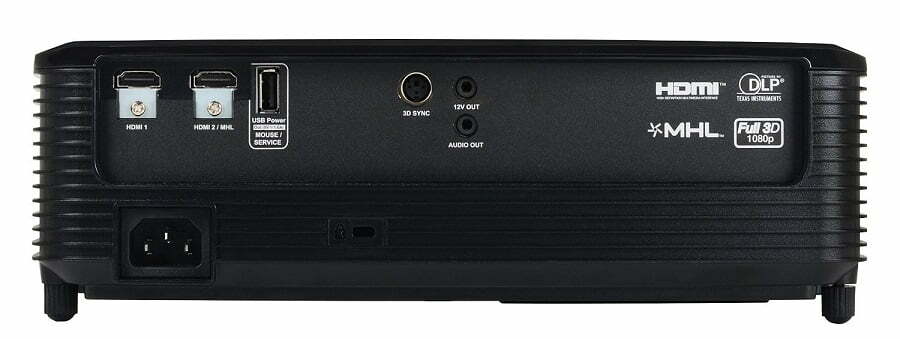
Similar to the Optoma HD141X 3D projector, the Optoma HD142X uses DMD-chip DLP technology to create its images at a maximum display resolution of 1920 x 1080 at a contrast ratio of 23,000:1, with the ability to show an image as large as 305.5″ across from corner to corner at a distance of 32 feet.
Although the hardcore projector junkies may not be happy with Optoma’s decision to cut down on the number of available ports, personally I love that they’ve simplified things in order to save on costs. With only two HDMI 1.4/MHL ports, a USB power port, one audio out, and a 3D-sync slot, the Optoma HD142X takes the title for the most streamlined projector we’ve tested to date when it comes to what it’s sporting on the back.
User Interface and Settings
As is the case with the design of the HD142X, not a whole lot has changed from what we first found on the HD141X. It’s set to replace Optoma’s lineup of budget-oriented home theater projectors.
Brightness, contrast, and picture settings are all controlled from a single menu, while four-corner keystoning makes a reappearance as the primary method used to fit the image to your screen. Presets included options for Cinema, Gaming, sRGB, and Reference, each of which changed options such as the color temperature and the response times depending on what particular application you’re using or the type of content you plan to watch.
Testing and Performance
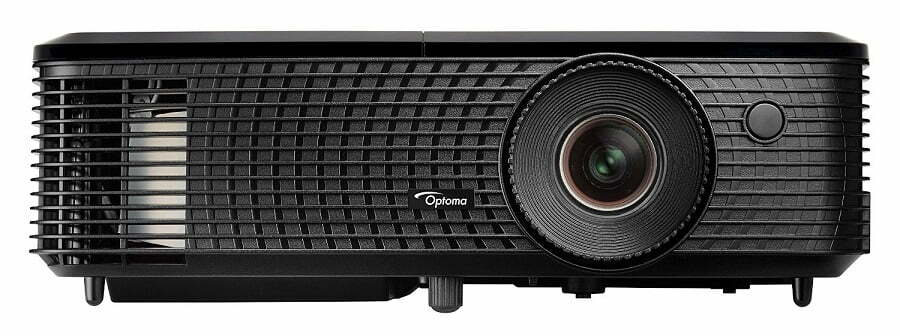
Brightness/Picture Quality
If there’s one thing Optoma is known for by now, it’s making seriously bright projectors that won’t break your budget in half by the time you hit the checkout counter. The HD142X is no different, with 3,000 ANSI lumens of brightness that fill the room with light even during the brightest of days.
At a distance of 10ft in near-darkness, we recorded a rating of 1,672 lux in the middle of the image, and a variable rate of 1,250 – 1,550 lux around the corners. At 7ft this stat jumped considerably, to 2,486 lux in the middle of the image, and 2,132 lux at the outermost corner.
Read More: Best 4K Projector
Aside from making extremely bright projectors on the cheap, Optoma is also great at making projectors that look just as good as competing models that can run at twice or three times the same cost. Movies and TV streamed from various sources, as well as source 4K video, looked amazing on the Optoma during ambient light tests as well as the dead of night, with very few noticeable frame drops or bad focus.
Gaming Performance
Like the Optoma HD28DSE 3D DLP projector, the HD142X may not be the fastest projector out there with a mere 60Hz refresh rate and sub-optimal response times, but it was still plenty fast even when we booted up games that needed the bleeding edge when it comes to raw performance.
3D Performance
Unlike some other 3D projectors which are locked to a set refresh rate, the Optoma HD142X can send itself into overdrive to 120Hz (144Hz advertised) in 3D mode in order to compensate for the refresh rate “sickness” that some people can feel while wearing 3D glasses for extended periods of time. To learn more about 3D capabilities on projection devices, you’ll want to read our article about 3D ready vs full 3D projectors.
The addition pays off, and makes watching 3D content a whole lot more bearable over long periods of time. As it goes with most projectors, the viewing angles to maintain the 3D effect were fairly limited, though this seems to be more of a problem with the choice to go with DLP than anything else that Optoma could control themselves.
Noise and Heat
As far as noise and heat are concerned, this is one area where the HD142X excelled over the rest of the competition. We barely noticed a whisper of noise out of the fan when it was turned on and the projector was doing its hardest work (3D content at 144Hz), and the heat signature was just about the same. If you want to keep this projector next to your head on a wall mount, you’ll barely even notice it’s there.
Sound
With a 10W mono speaker onboard, you’d think the Optoma HD142X would have enough power to pump out some decent sound, but no luck. The speaker, while loud, sounded pretty terrible under most conditions, including music and movies that were softer on the bass but still suffered thanks to the projector’s lackluster onboard drivers.
Wrap Up
As it should be with most projectors, the HD142X doesn’t make a ton of strides to completely revolutionize the industry with a single product, but rather make steady, small improvements on all sides instead. It may not be immediately obvious why you would buy this over the HD141X, but it’s more about the subtle additions like the 8,000-hour lamp life and four-corner keystoning that make it just a slightly better projector all around.
If you’re a stickler for perfect color representation or screaming gaming performance you’re likely better off going with the Epson Home Cinema PowerLite 1440 or BenQ HT4050, respectively, but if you’re on a budget and need something that gets the job done for not a lot of cash, the $609 Optoma HD142X is a decent pick for your first personal theater setup.
Read More: How many watts does a projector use?
Related Articles:
